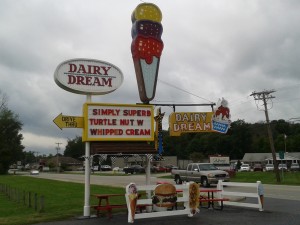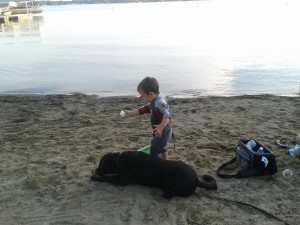I woke up in Muncie, which is the closest spot to home for me in Indiana. For all of my life until his death in 2003, it was the home of my uncle, Rev. William Grady, who was the pastor at St. Mary Church. The night before, I had made contact with two friends from the parish, and was able to share dinner with one of them and catch up a bit on the parish. So, after leaving the hotel, I headed over to St. Mary’s to look around. It is an interesting and beautiful location, as the parish was built onto the estate of a wealthy turn-of-the-20th century entrepreneur. Over time, the parish re-purposed the buildings on the estate, built new buildings to meet their needs, and Christianized the sunken garden.
I wandered around, feeling a bit like an intruder in a place that had been such a big part of my life because there was nobody left at the rectory who would know me if I stopped in. I wandered over to the school and was surprised to find no evidence of children. Given that the day was the first day back from Labor Day, the empty classrooms were particularly striking. I had not heard that they had closed the school, but I suddenly found myself welling up with tears. Of course there would be change after Fr. Bill’s death, but he was so proud of that school. Suddenly, the loss of him and of the life I knew there was very raw. In my wanderings on the grounds, I finally saw an adult come out of one of the abandoned school buildings and learned that the children and staff were all over at lunch. It was a great relief, and I suddenly became conscious that Tamu and I could be disruptive to the return of the kids from lunch, that there was ordinary life to be getting on with there, and I was just a stranger lurking near a school. I headed back across the grounds and noticed that a police officer was parked in view of my car, and I wondered if somebody had called him because of the presence of a strange woman with her enticing puppy on the grounds with too enthusiastic an interest in the children. Rather than slink away with my car, I walked directly up to him and explained my presence. I’m glad I did, because it turns out that he was not called to the grounds, but was a long-time parishioner who likes to do his paperwork there because of the peace of the place. The minute I mentioned that my uncle had been pastor, he recognized the family resemblance himself. So we chatted about the parish, and he lifted my spirits. Ten years later, parishioners are as passionate about the parish as they were when Fr. Bill was alive. The buildings and the gardens may change, but the community is still committed. When I finally headed out, my heart was lighter than it had been when I arrived. From there, I went over to the cemetery to pay my respects. It is still strange to visit Muncie without seeing Fr. Bill, but I was happy to be there.
At this point, I was hungry. The next item on my list was an ice cream joint called the Dairy Dream, and I was hoping that it served something substantive too, as I needed a meal. I arrived in Albany to find an ice cream shop on steroids.
I was happy to see that I would be able to order lunch, but this presented a dilemma. The house specialty was their famous sloppy joe sauce, but the two-fer special on Tuesday was hot dogs. I asked the person manning the booth for a recommendation, and found myself with two hot dog covered in sloppy joe sauce. Delightful. I fueled up on this and an ice cream sundae, and headed up the road with no need to stop for more food later in the day.
Next stop was Huntington, home of Dan Quayle, and the Dan Quayle Museum of the Vice Presidency. This little gem was recommended to me by a Hoosier friend, Matt Schieber, who clued me in that it was not so much a museum to Dan’s Vice Presidency as it was to the institution itself. It is a charming place, formerly a Christian Science Reading Room, now converted into displays for each of our Vice Presidents. I learned lots of interesting nuggets about men I had never learned much about in school, and got a few updates on the Quayles, who live in Arizona now.
Still, I’m not sure I would be able to differentiate Dan Quayle from Pat Sajak if I were pressed, and his wife was not with him. Would you?
Nearby, was an Indiana winery, my first such stop in the trip. I was surprised to see a winery so close to my home of northwest Ohio, as the area outside Lake Erie is not generally known for its wine. I was even more surprised when I got there to find a fairly significant operation. Only a few years old, owned and operated by two young people, Two EEs Winery was pleasant, welcoming, and offered a nice selection.
 What surprises me is to see new enterprises in the area. Huntington itself, like many of the smaller Indiana towns I have seen so far, seems in decay. You can see the bones of the old, vibrant, small town, but there are empty shop fronts and lots of repurposing of old institutions, and the Victorian homes and craftsman bungalows the surround the town are deteriorating. The agricultural industry looks healthy as I move between towns, but the towns themselves have seemed to be struggling. Yet, here was a winery, a risky start-up it seems to me, with a splashy and expansive new building and young ownership. May they succeed.
What surprises me is to see new enterprises in the area. Huntington itself, like many of the smaller Indiana towns I have seen so far, seems in decay. You can see the bones of the old, vibrant, small town, but there are empty shop fronts and lots of repurposing of old institutions, and the Victorian homes and craftsman bungalows the surround the town are deteriorating. The agricultural industry looks healthy as I move between towns, but the towns themselves have seemed to be struggling. Yet, here was a winery, a risky start-up it seems to me, with a splashy and expansive new building and young ownership. May they succeed.
I pressed on to Ligonier, home of an even riskier venture, the Annie Oakley Perfumerie. I arrived within the half hour before they closed, but I received a warm welcome, was invited to sample the perfumes and oils, and left with some complementary verbena. Apparently, that business began in the kitchen of the founder, and now has a seemingly stable presence on the outskirts of the town. I took the opportunity to walk Tamu around the downtown, which is known for its collection of murals depicting its history.
Like other small towns, and despite the colorful murals, Ligonier itself seems to be in decline. Most of the buildings needed some repair. The history depicted is of native American and then settler life, moving into the 20th century with images of young people in the 1950’s visiting movie theaters and dance halls. The town itself seems now to be largely Spanish-speaking, with one restaurant advertising its weekly Ethiopian meal. Tamu and I wandered around, stopped to chat with a newly minted fourth grader who told me about her Rottweiler at home, and then we headed back for the car. It was, once again, time for a wine tasting stop, and the Country Heritage winery was along the path. Again, this was a sprawling place in Laotto, newly constructed in 2011, with a very large tasting room and outdoor seating area. Pleasant as well, but like the previous, a curiosity amidst the corn and soy fields and decaying storefronts of small town life.
We ended the day with a jaunt to Pokagon State Park in Angola. I should note that I have a personal history with this place. My brother held his wedding reception here fifteen years ago, and in the midst of it, the Potowatomi Inn lost power and had very little to offer from their back up generator. The reception was cut very short when there was no music, and little by way of food or toilets or lights or AC. As a result, I had low expectations of the place. I went in–despite the state park admission fee so close to sunset–to give Tamu an extensive walk. I was pleasantly surprised by the place. After a brief stop at the inn, Tamu and I headed toward Lake James. The water was crystal clear. Although he did not get in, Tamu rolled about in the sand on the beach, frolicked with a small child, and played fetch with a found tennis ball.
We paused and enjoyed a peaceful end to our busy day. The toddler’s parents told me that the park is one of the best in America. With a beach all to myself, and a contented dog at my side, pleasant temps and clear water, I may actually believe them.











2 Responses to Day 2: Muncie, Albany, Huntington, Ligonier, Laotto, and Angola